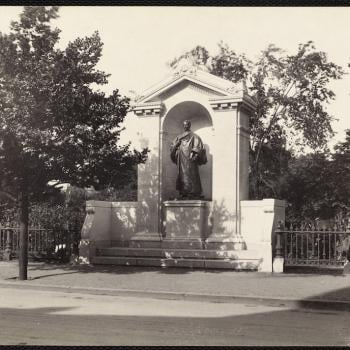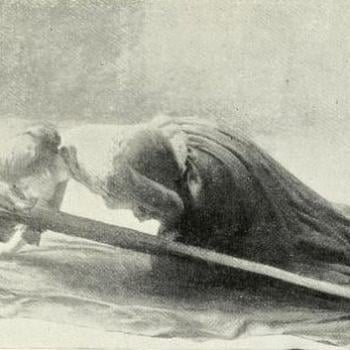STAR OF THE EAST
A dharma talk
High above the Pacific Ocean on an Hawaiian volcano, on a ridge where the California coastal range merges with the Sierras, on a plateau just below a peak in the Andes, at a point in space, far out in the void, in all these places you will find observatories, where light pollution can’t obscure the night sky, there where the atmosphere thins, sometimes, where there is no atmosphere at all.
And in those domes, and on those satellites, new telescopes are being assembled and calibrated, waiting for what astronomers call “First Light”, that moment when the light of a distant star first touches those immense concave mirrors, the first star that that telescope ever sees, ever registers, the light that first awakens those complex collections of metal, plastic and glass. You have to wonder how many of those astronomers see the parallels between their instruments’s first glimpse of the vast, of the unfathonable universe, and that morning star some twenty five hundred years ago seen by an emaciated former prince, sitting resolutely all night beneath the bodhi tree.
My brothers and I, back when I lived in California, would set aside a few days each fall, to go backpacking in the Sierras, high up in the mountains, where the night sky was undimmed by street lights. I woke up one morning, very early, before dawn, the dark and the frost on the tent belying the notion of a Sunny California. I crawled out of my sleeping bag, went out and laid down on a flat rock overlooking a quite, calm mountain lake and looked up at what was still the night sky. And, lying there, there was a shift, a subtle change in persective, and I was no longer looking up at the night sky overhead. No, pinned on the earth’s surface, I was looking down, down into the depths of the universe, deep, deep, past stars, past galaxies, down with the universe laid out below me. Gradually, the sky went from black to indigo, to a brighening in the east, just over the ridge, and as it did, the sky righted itself, the universe turned, and the first rays of the sun broke through. First Light! The whole earth came alive, chipmunks racing across gravel, crows and ravens calling out to each other, tumbling across the sky, the air, warmed by the risen sun, moving through the trees, rustling the pine needles, hawks, searching for prey floating overhead, my two brothers, stirring in their tents.
I like to think that on a morning like that, after a night like that, Siddartha Gautama sat under the Bodhi tree, opening himself to that quiet Nepalese dawn, struck by the faint twinkling of the morning star, by the rising of the morning sun. In the Transmission of the Lamp, Kaizan Jokin tells the story like this: Shakyamuni Buddha was descended from the Sun lineage in India. At the age of 19, he left Kapila palace at midnight for Mt. Dantokuzanz where he cut off his hair and renounced the world. Then he began six years of ascetic practices. After that he sat on the Diamond Seat, in ultimate samadhi, where spiders spun webs between his eyebrows and magpies built nests on his head. Reeds pierced his Lotus posture for another six years. On December 8, during his thirtieth year, he attained enlightenment when the morning dawned. The words, “I together with the great earth and sentient beings, simultaneously attain the Way.”, were his first lion’s roar.
My step father had a cabin on a lake up in Maine, a place where he and his family would spend their summers going back to the late nineteen fifties. When he and my mother became a couple and then married, we became part of that family and would often drive up to spend week-ends at his cabin. That end of the lake had become a kind of New Jersey colony in exile as neighbors of Dick’s from southern New Jersey moved in around his place. If you wanted to avoid their noise, the slamming of screen doors, the shouting across from porch to porch, the roar of an occasional power boat, jetski, or chainsaw, it was best to get up early, walk down the path to the lake, out to the end of the dock, and there enjoy the early morning peace, the solitude, the silence and the change in the light that grew over the lake as the night faded, the sky slowly brightened and the sun came up over the pines to the east. At that hour, the surface of the lake was like glass, the sun’s heat hadn’t yet stirred up the wind and scattered wavelets over the waters. Mist would still drift on the face of the lake and, close to shore, the aquatic grasses would be standing up out of the water, catching tatters of those mists. If you were lucky and quiet, you’d see and hear a loon would be gliding off in the distance, calling out to its mate, lonely, lonely like the sound of a distant train out on the pairie.
Dawn, Homer’s rosy fingered dawn, a time to open yourself to what Camus called “the benign indifference of the universe” The hawks, the pine needles, the chirps of the racing chipmunks, that splash from a jumping fish, the croaking of a hidden frog, none of these cared if you stood up on that dock, yet there in the early morning light they opened their arms to you just as you, in that moment of transcendent calm and beauty, would find yourself embracing them, being one with that serene, yet everyday ordinariness – the water, the rocks, the pines, pine needles bowing in the faint breeze of early morning. That brief time when you and the world around you became one, that moment when you glanced up and saw, if not the morning star, then the rays of the dawning sun.
When I was a child, one of my favorite hymns, favorite probably because we sang it at this time of the year and it signaled the, if you’ll forgive the semi-theological pun, the advent of Christmas, that favorite hymn went:
Brightest and best of the sons of the morning,
dawn on our darkness and lend us your aid.
Star of the east, the horizon adorning,
guide where our infant Redeemer is laid.
It is amusing to realize that this gentle, this sweet hymn by Reginald Heber was critisized both for hinting at the worship of stars and for having a solomn, dance-like rhythm. I suppose that in the early nineteenth century, even solomn dancing might have been too much for critics of hymn tunes. And I have to wonder, did the Buddha dance upon seeing that morning star? A joyful dance? Perhaps a stately, a solemn dance, a saraband, a dance recognizing the suffering of the world. For those stars, and the great sun itself, sons of the morning, all dance to the solemn music of the spheres, are all both benign and indifferent, shining on us in times of joy and of sorrow, and of both together, the great catastrophe.
Arthur C. Clarke wrote a short story set on the scorched remenants of an ancient civilization, a civilization prosperous, peaceful, artistic, that had been wiped out in an instant when its sun went supernova. Astronauts from earth, one of them a Jesuit priest, there to study this, their first encounter with an alien if extinct people, came to realize that the planet’s star, in going supernova would have been seen on earth as a bright star over the town of Bethleham, announcing the birth of Jesus – Brightest and best of the sons of the morning, had it been five hundred years earlier, perhaps it would have brought Siddartha to his feet and caused him to say “I together with the great earth and sentient beings, simultaneously attain the Way. ” And if that great joy, that moment of awakening together with the great earth had been triggered by calamity, was it any the less?
Still, star of the east, Morning star, sun rise, the promise of a new day, of a new way of being in the world. This is our gift at this time of the year, born of a mixture of joy and grief, of success and failure, of wins and losses, the great mess. If, on that morning 2500 years ago, Siddhartha had glanced up to a cloudy sky and been awakened by a snow flake drifting down, would that gift of awakening have been diminished? Do the thorns edging the holly leaves make the red berries on the holly tree any the less lovely?
Keizan’s gift to us in this season of gift giving was set out by him as he tells us:
“This mountain priest would like to add some humble words on the subject. Are you monks ready to listen?”
One branch grows beautifully from the old plum tree.
In time, thorns also sprout.
Edward Sanshin Oberholtzer is the resident priest and guiding teacher of the Joseph Priestley Zen Sangha in Lewisburg, Pennsylvania.
The image is a detail from a Paestan skyphos of a dancing maenad.
.













